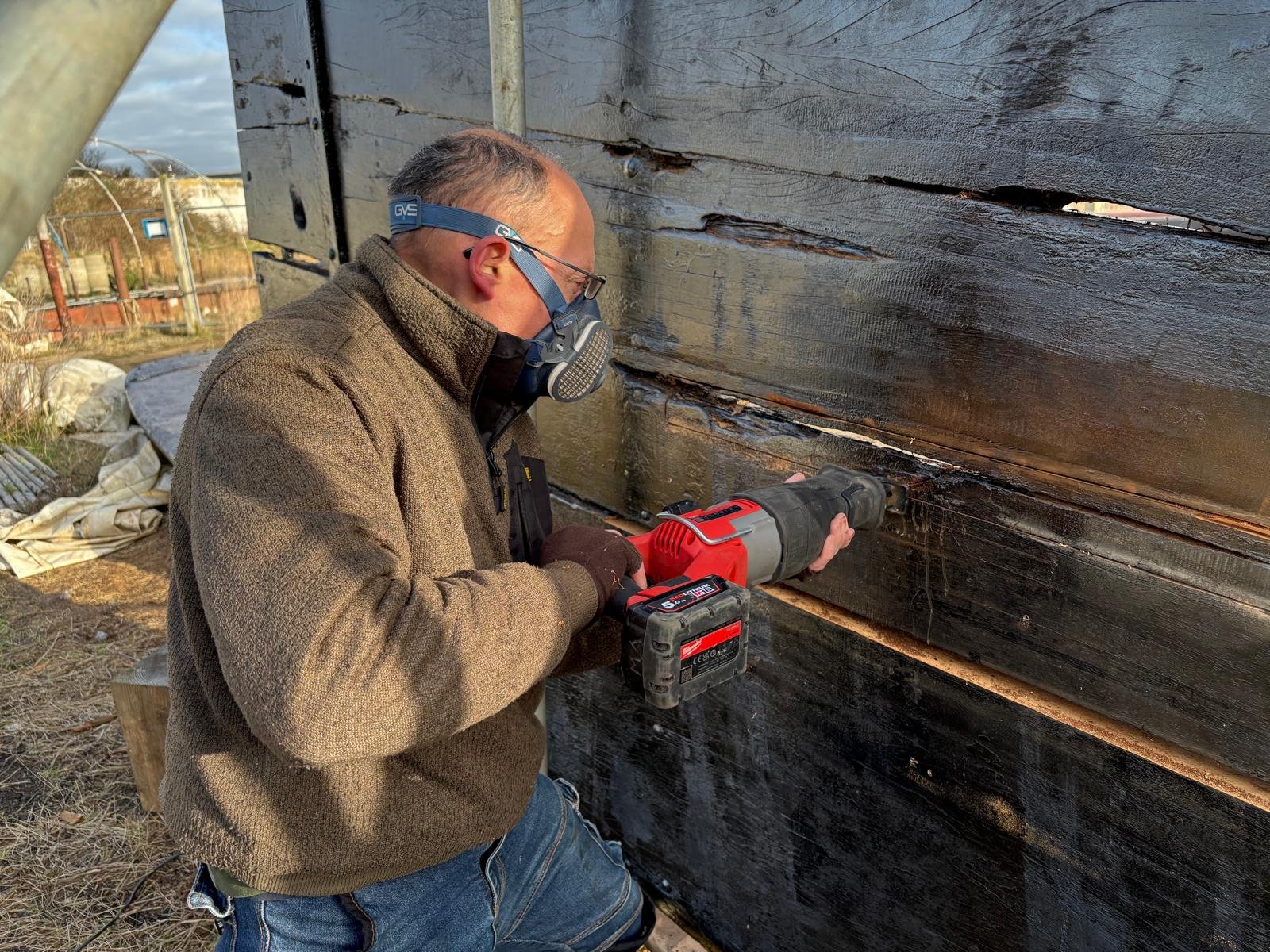Raybel re-rigged
March 2025
Into the new year – and the signs of Raybel’s imminent readiness to sail come along almost weekly now.
Returning to the wharf in the new year, a set of brave volunteers, some going into their sixth year on the project, faced gruelling days in the cold, wet January as they set about getting as much prep work done as possible, ahead of deadline day – Feb 17th.
This was when we’d booked local company Moltus to arrive with a telehandler to lift on the main mast, spreet, boom, rudder, along with one of the leaboards, onto the barge. Before then, spars were to be sanded, varnished and painted; leaboards filled, sanded and painted; cross trees and treadle trees (metal rods making up part of the high rigging) to be sanded and painted; the topmast sanded and oiled; cables tarred; and final rudder components fixed.
Crane day and raising the gear
The gear had all been lifted off, back in 2020, with a huge crane. To put it back on we were going for the lighter option, with a smaller telehandler. This took some calculating what was feasible: we were sure the main mast, spreet, boom, rudder and one of the leaboards would go back on OK. The far leaboard would be too much of a stretch, and would be left for another day, and for when Raybel had been turned around. All goes to plan.
Next milestone up …. just one week later and the gear is raised, lifting the mast upright from flat on the deck, with the mainsail and topsail now attached. Over the previous five days shipwright team of Laurie, John and Alanna worked flat out, supported by metal worker Reuben and volunteer help from ‘Shiner’, attaching the fore and main sails to the masts, securing the ‘eyes’ on the mainsail, carrying out some repairs where it been damaged during storage (those rats again); attaching the ‘sheets’ (the ropes used to control the movable corners of the sail), then ‘dressing’ the mainsail.
Sadly ‘dressing’ meant painting it with a broom in ochre red fence paint, as the sail, made 15 years ago but never used, is made from a synthetic material called Duradon. Traditional flax would have been preferred, but flax material is no longer available in the size and strength needed for sails. Though there are signs of a re-emergence, and our sailmaker Steve Hall in touch with farmers and flax weavers starting up in the west country.
Somehow the myriad jumble of ropes, wires and tackle that is laid out on the wharf at the beginning of the week has been assembled and is onto the rig by the end. On the morning of Feb 24th, cold, heavy rain relents in time for a super-keen volunteers to put their arms, shoulders and hearts to the windlass, winding up the gear, which takes a solid 30 minutes effort. By the afternoon the rig is resplendent against the scudding clouds over the Creek.
Mizzen and more
Next up, the mizzen mast, boom and spreet, are given seven coats of varnish by Rob over a week in early March, the spars having been moved inside the museum as it’s too cold for the varnish to dry.
Then there’s the mass of small unexpected jobs that come up – the steering gear (connecting the wheel to the rudder) has a bolt sheared off, and the threading is worn. More work for metal worker Reuben. Chain plates that hold cables and ropes secured to the side of the barge need adjusting and slightly repositioning. The start of the mast raise is delayed when Rob notices a crack in the weld on one of the mast rings. Get Reuben back. The anchor and chain need lifting back on board. The wheel is retrieved from storage and goes back on too.
Meanwhile, out of sight below decks a whole other task is now underway, with marine electrician Colin Wilson contracted to install a new electric system. Gone are the days when a sailing barge would set off with nothing more than a woodburning stove and some oil lamps. Now we need navigation equipment, chart plotters, depth sounders, lights in the hold. All of this will be powered by a bank of lithium batteries, connected to a 24v system for offshore use.
By mid-March the mizzen mast is up, adding one more component to the increasingly complex rigging set-up ….and with Raybel now pointing down-Creek in anticipation of the sails unfurling to the winds.
Images: Simon repairs leaboard; Paul and Alan painting main mast; craning on the spreet; fixing on the rudder; winding up the mast; gear raising team celebrate; Alanna clearing the rigging lines; Raybel re-rigged with main mast; and from above.









